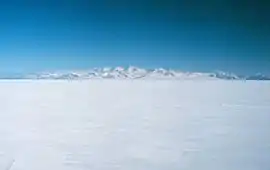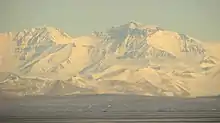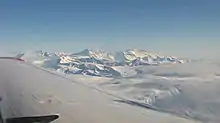Royal Society Range
The Royal Society Range (78°10′S 162°40′E) is a majestic mountain range in Victoria Land, Antarctica. With its summit at 4,025 metres (13,205 ft), the massive Mount Lister forms the highest point in this range. Mount Lister is located along the western shore of McMurdo Sound between the Koettlitz, Skelton and Ferrar glaciers. Other notable local terrain features include Allison Glacier, which descends from the west slopes of the Royal Society Range into Skelton Glacier.
| Royal Society Range | |
|---|---|
 View of the Royal Society Range from the Ross Sea | |
| Highest point | |
| Peak | Mount Lister |
| Elevation | 13,205 ft (4,025 m) |
| Coordinates | 78°10′00″S 162°40′00″E |
| Geography | |
 Map depicting the location of the Royal Society Range in Victoria Land, Antarctica
| |
| Continent | Antarctica |
| Region | Victoria Land, Antarctica |
| Parent range | Transantarctic Mountains |


Discovery and naming

The range was probably first seen by Captain James Clark Ross in 1841.[1]
The range was explored by the British National Antarctic Expedition (BrNAE) under Robert Falcon Scott, who named the range after the Royal Society and applied names of its members to many of its peaks. For example, Mount Lister was named for Lord Joseph Lister, President of the Royal Society, 1895-1900.[2] The Royal Society provided financial support to the expedition and its members had assisted on the committee which organized the expedition.[1]
Geology
The Royal Society Range consists of a Precambrian igneous and meta-igneous basement complex overlain by Devonian- to Triassic-age sandstones, siltstones and conglomerates of the Beacon Supergroup which dip shallowly westward away from the Ross Sea coast.[3] The entire region is cut by north-south trending longitudinal faults, east-west trending transverse faults, and structurally related dike swarms.[4]
Tectonic and fluvial activity have featured very heavily in the recent geologic history of the Royal Society Range. Following the extension of the Ross Sea Basin (c. 55 million years ago), an episode of uplift drove the creation of the Royal Society Range rift flank. At this time a tectonic (though not accretionary) wedge, up to 6 km thick on the coast, was present, though it quickly began to erode due primarily to fluvial processes, and the Royal Society Range was cut down near to its present appearance by the mid-Miocene. Relatively limited glacial action since that time has preserved much of the fluvial architecture of the Range, and though uplift did not cease, its magnitude is such that it has not drastically affected the landscape, having progressed only 67 meters in the last 8 million years.[3]
Koettlitz Glacier Alkaline Province
Neoproterozoic tectonic extension along the edge of the East Antarctic Craton between the Skelton and Koettlitz Glaciers resulted in the emplacement of coarse grained alkaline igneous intrusive rocks (ranging from gabbro to A-type granite). This area of alkaline intrusives is referred to as the Koettlitz Glacier Alkaline Province[5]
Ross Orogeny
Cambrian tectonic convergence, continental collision and plate subduction led to the emplacement of calc-alkaline and adakitic granitoids. This period of mountain building is referred to as the Ross Orogeny.
Volcanic history
The Royal Society Range contains over 50 basaltic vents, ranging in size from tiny mounds to cinder cones up to 300 meters (985 feet) high. Dating of surface material indicates they were active earlier than 15 million years ago (e.g. Heald Island)[6] and as recently as 80,000 years ago, with glacier-bound tephra layers suggesting even more recent Holocene activity.[7] The vast majority of vents are located in the foothills of the Royal Society mountains just north of Koettlitz Glacier, and most are Quaternary in age. Most emanating flows are 3–10 meters thick and less than 4 kilometers long. The composition, with very few exceptions, is porphyritic basanite with primarily olivine and clinopyroxene phenocrysts, though some phenocrystic plagioclase is also present.[8]
Features
- Abbott Spur
- Allison Glacier
- Amphitheatre Glacier
- Anne Hill
- Auster Pass
- Ball Glacier
- Baronick Glacier
- Battleship
- Berry Spur
- Bindschadler Glacier
- Bishop Peak
- Boom Basin
- Borg Bastion
- Brandau Crater
- Bubble Spur
- Carleton Glacier
- Cathedral Rocks
- Chancellor Ridge
- Chaplains Tableland
- Columnar Valley
- Comberiate Glacier
- Copland Pass
- Covert Glacier
- Craw Ridge
- Dale Glacier
- Dot Cliff
- Dromedary Glacier
- Emmanuel Glacier
- Engebretson Peak
- Ferrar Glacier
- Fisher Bastion
- Fogle Peak
- Foster Glacier
- Frio Peak
- Frostbite Spine
- Harvey Summit
- Heke Peak
- Henderson Pyramid
- Highway Ridge
- Hofmann Spur
- Hooker Glacier
- Hooper Crags
- Horseshoe Crater
- Howchin Glacier
- Ibarra Peak
- Inan Peak
- Jezek Glacier
- Jigsaw Rock Gut
- Johns Hopkins Ridge
- Joseph Lister
- Kamb Glacier
- Kenney Nunatak
- Koettlitz Glacier
- Lava Tongue Pass
- Lettau Peak
- Lister Glacier
- Lower Jaw Glacier
- Maine Ridge
- Margaret Hill
- Matataua Glacier
- Mata Taua Peak
- McConchie Ridge
- McDermott Glacier
- McMurdo Dry Valleys
- Mitchell Glacier
- Mount Bockheim
- Mount Chiang
- Mount Cocks
- Mount Duvall
- Mount Essinger
- Mount Fuller
- Mount Hooker
- Mount Huggins
- Mount Huxle
- Mount Kempe
- Mount Lisicky
- Mount Lister
- Mount Mignone
- Mount Moxley
- Mount Rucker
- Mount Schwerdtfeger
- Mount Stearns
- Mount Windle
- Murcray Heights
- Murihau Peak
- Navajo Butte
- Pearsall Ridge
- Platform Spur
- Potter Glacier
- Poutini Peak
- Puke Toropa Mountain
- Radian Glacier
- Rampart Ridge
- Rester Peak
- Royal Society
- Rucker Ridge
- Rutgers Glacier
- Salient Glacier
- Salient Peak
- Salient Ridge
- Shupe Peak
- Skelton Glacier
- Skelton Névé
- Sladen Summit
- Solomon Glacier
- Solomon Saddle
- Sphinx Valley
- Spring Glacier
- Stoner Peak
- Tasman Ridge
- Terminus Mountain
- The Pimple
- Transit Ridge
- Tuati Peak
- Umran Inan
- Waiparahoaka Mountain
- Walcott Glacier
- Ward Glacier
- Ward Lake
- Wirdnam Glacier
See also
References
- "Royal Society Range". Geographic Names Information System. United States Geological Survey. Retrieved 2004-11-13.
- "Mount Lister". Geographic Names Information System. United States Geological Survey. Retrieved 2010-02-09.
- Sugden, D.E., Summerfield, M.A., Denton, G.H., Wilch, T.I., McIntosh, W.C., Marchant, D.R., and Rutford, R.H., 1999, Landscape development in the Royal Society Range, southern Victoria Land, Antarctica: stability since the mid-Miocene: Geomorphology, v. 28, p. 181-200.
- Wilson, T.J., 1995, Cenozoic transtension along the Transantarctic Mountains–West Antarctic rift boundary, southern Victoria Land, Antarctica: Tectonics, v. 14, 531–545.
- Read, S. E. (2010). Koettlitz Glacier Alkaline Province : Late Neoproterozoic extensional magmatism in southern Victoria Land, Antarctica (Thesis, Doctor of Philosophy). http://hdl.handle.net/10523/5428
- Wilch, T.I., 1991, The surficial geology and geochronology of middle Taylor Valley Antarctica: Implications for Plio-Pleistocene Antarctic glacial history [M.S. thesis]: Orono, The University of Maine, 363 p.,
- Armstrong, R.L., 1978, K-Ar dating: Late Cenozoic McMurdo Volcanic Group and Dry Valley glacial history, Victoria Land, Antarctica: New Zealand Journal of Geology and Geophysics, v. 21, p. 685-698.
- Wright, A.C., and Kyle, P.R., 1990, Royal Society Range Summary, in LeMasurier, W.E., and Thomson, J.W., eds., Volcanoes of the Antarctic Plate and Southern Oceans: Washington, DC, American Geophysical Union, Antarctic Research Series, v. 48, p. 81-88.